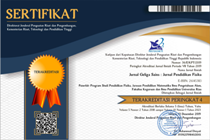IMPLEMENTATION OF PEER INSTRUCTION INTEGRATED GUIDED INQUIRY LEARNING TO INCREASE ARGUMENTATION SKILL OF SCIENCE JUNIOR HIGH SCHOOL STUDENTS
Abstract
This research aimed to know the differences in the science physics argumentation skills of students learning with the Peer Instruction Integrated Guided Inquiry Learning model and conventional learning. The research method used was quasy experiment with posttest only control design. The research population was all eighth grade students of Junior High School (SMP) 3 Pekanbaru. Samples were taken from two classes chosen by simple random sampling, namely class VIII5, totaling 36 students as the experimental class and class VIII4, totaling 36 students as the control class. The research instrument used a test argumentation skills. Data collection techniques through argumentation skills tests, after the learning process is carried out in both classes. Data were analyzed descriptively by looking at the results of students' argumentation skills scores and inferential using the T-test. The results of descriptive analysis showed that the experimental class argumentation skills were good enough, while the control class categorized was less good with a difference of 22.84%. Inferential there were significant differences in students' argumentation skills in class learning vibration and wave material with Peer Instruction Integrated Guided Inquiry Learning model to conventional class. The use of Peer Instruction Integrated Guided Inquiry Learning model in learning science of physics of vibration and wave material in class VIII5 of SMP 3 Pekanbaru, can increase the ability of students' argumentation skills.
Keywords
Full Text:
PDFReferences
American Association of Colleges for Teacher Education(AACTE) (2010). 21st Century Knowledge and Education. New York: National Education Association.
Cho, K.L & Jonassen, D.H. (2002). The Effects of Argumentation Scaffolds on Argumentation and Problem Solving. ETR&D, 50 (3), 5-22.
Crouch, C.H. & Mazur, E. 2001. Peer Instruction: Ten Years of Experience and Results. Department of Physics. Harvard University, Cambridge.
Erduran, Simon,Shirley., dan Osborne,J. 2004. TA Ping into Argumentation: Development in the Aplication of Toulmi'sArgument Pattern for studying SCcience Discourse. Jurnal Science Education. 88 (6). : 915-933.
Mahmuda Noviyani, Sentot Kusairi dan Mohamad Amin. 2017. Penguasan Konsep dan Kemampuan Berargumentasi Siswa SMP Pada Pembelajaran IPA dengan Inkuiri Berbasis Argumen974. Jurnal Pendidikan: Teori, Penelitian, dan Pengembangan Volume : 2 Nomor : 7 Bulan Juli Tahun 2017 Hal : 974-978.
Mc. Neil, K. L., Lizotte, D. J., & Karjcik, J. (2006). Supporting Student’s Construction of Scientific Explanations by Fading Scaffolds in Instructional Materials. The Journal of The Learning Science, 15 (2), 153-191.
Muslim dan Suhandi A. (2012). Pengembangan Perangkat Pembelajaran Fisika Sekolah untuk Meningkatkan Kemampuan kognitif dan Keterampilan Berargumentasi. Jurnal Pendidikan Fisika Indonesia, 8:174-183.
Permendikbud. 2013. Permendikbud No. 64 Tahun 2013 tentang Standar Isi Pendidikan Dasar dan Menengah. Depdiknas. Jakarta.
Punaji Setyosari. 2010. Metode Penelitian dan Pengembangan. Kencana. Jakarta.
Putra dan Sitiatava Rizoma. 2013. Desain Belajar Kreatif Berbasis Sains. Diva Press. Yogyakarta.
Putri Handayani & Murniati Sardianto. 2015. Analisis Argumentasi Peserta Didik Kelas X SMA Muhammadiyah 1 Palembang dengan Menggunakan Model Argumentasi Toulmin. Jurnal Inovasi dan Pembelajaran Fisika. 2 (1): 60-68.
Redish, E. F., Saul, J. M., &Steinberg. 2008. Student Expectation in Introductory Physics. American Journal Physics, 66(2): 212-224.
Siswanto, I. D. Kaniawati & Suhandi, A. 2014. Penerapan Model Pembelajaran Pembangkit Argumen Menggunakan Metode Saintifik Untuk Meningkatkan Kemampuan Kognitif dan Keterampilan Berargumentasi Siswa. Jurnal Pendidikan Fisika Indonesia. 10 (2): 104-116.
Sondang R. Manurung. 2012. Identifikasi Keterampilan Argumentasi Melalui Analisis “Toulmin Argumentation Pattern (TAP)” pada Topik Kinematika bagi Mahasiswa Calon Guru. Seminar Bidang Ilmu Mipa Universitas Negeri Medan.11-12 Mei 2012.
Suyatno. 2009. Menjelajah Pembelajaran Inovatif. Mas Media Buana Pustaka. Sidoarjo.
Trianto. 2011, Mendesain Model Pembelajaran Inovatif Progresif. Kencana. Jakarta.
Von Aufschnaiter, C. 2008. Arguing to learn and learning to argue: Case studiesof how students' argumentation relates to their scientific knowledge. Jurnal of Research in Science Teaching, 45(1)hlm.101-131.
Wenning, Carl J. 2010. Levels of inquiry: Using inquiry spectrum learning sequences to teach science. Jurnal Phys Tchr. Educ, 5 (3): 11-20.
Zohar, A. & Nemet, F. (2002). Fostering students knowledge and argumentation skills through dilemmas in human genetics. Journal of research in science teaching, 39 (1), 35-62.
DOI: http://dx.doi.org/10.31258/jgs.7.2.119-127
Refbacks
- There are currently no refbacks.
Copyright (c) 2019 Nova Julianti, Azhar Azhar, Muhammad Nasir

This work is licensed under a Creative Commons Attribution 4.0 International License.
Jurnal ini terdaftar dan terindeks pada:
- Crossref
- Google Scholar
- Crossref
- Garuda
- Sinta
- Researchgate
- Dimensions
- Base
- Scilit
- OneSearch
- Road
- CiteFactor
- ResearchBib
- WorldCat



















